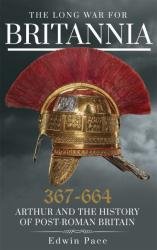 Название: The Long War for Britannia 367–664: Arthur and the History of Post-Roman Britain
Название: The Long War for Britannia 367–664: Arthur and the History of Post-Roman BritainАвтор: Edwin Pace
Издательство: Pen and Sword Military
Год: 2021
Страниц: 400
Язык: английский
Формат: pdf, epub
Размер: 10.1 MB
The Long War for Britannia is unique. It recounts some two centuries of ‘lost’ British history, while providing decisive proof that the early records for this period are the very opposite of ‘fake news’. The book shows that the discrepancies in dates claimed by many scholars are illusory. Every early source originally recorded the same events in the same year. It is only the transition to Anno Domini dating centuries afterward that distorts our perceptions.
Of equal significance, the book demonstrates that King Arthur and Uther Pendragon are the very opposite of medieval fantasy. Current scholarly doubts arose from the fact that different British regions had very different memories of post-Roman British rulers. Some remembered Arthur as the ‘Proud Tyrant’, a monarch who plunged the island into civil war. Others recalled him as the British general who saved Britain when all seemed lost. The deeds of Uther Pendragon replicate the victories of the dread Mercian king Penda. These authentic--yet radically different--narratives distort history to this very day.
On a cold autumn morning in 367, a Roman armada set sail for the island of Britain. Dozens of transports dotted the waters, their sterns rising like the tails of great leviathans. Roman legionaries crowded the decks. On one vessel, men carried the red shield of the Batavians, an elite unit in the Roman Army. Blue shields on another ship identified the troopers as Jovians. More vessels lumbered nearby. But none of these legionaries expected riches from this campaign. They were not sailing to conquer some new territory for the empire. This was instead a rescue mission. The Roman diocese of Britanniae was in peril, and only a massive amphibious force could save it.
The commander of this fleet was a man called Flavius Julius Theodosius. On that morning in 367, he wore the regulation dress of a high-ranking Roman officer. His red woollen cloak was held in place by a gilded crossbow brooch, while his chest and back were protected with heavy scaled armour. Finely tooled leather boots protected his feet from the chill breezes of the sea. Even the design on his shield proclaimed him as a Comes – a senior rank in the imperial army.
After many hours, the coast of Britanniae appeared through the mist like a dark, threatening wave. As Theodosius gazed at the distant shore, he doubtless had many thoughts. Most were practical ideas on how he would carry out his mission. But in the back of his mind was a question, a question he still could not answer: just how had barbarians overrun an entire Roman diocese? Why had Rome’s forces simply melted away? The reports made no sense. Nectaridus, the Commander of the Coast, was dead; Fullofaudus, the General of Land Forces, was missing in action. Bands of Irish and Pictish pirates roamed the countryside. Still worse, Rome’s army in Britain had put up no resistance. Some soldiers had even joined the invaders.
Скачать The Long War for Britannia 367–664: Arthur and the History of Post-Roman Britain